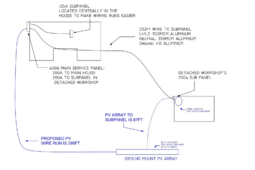goldenfab
New Member
I would like to do a ground mount PV array and the best location for it is about 300' from my house. I would rather not have the inverters and batteries in/on my house reasons being space, aesthetics, safety with kids, and potential for fire hazard. My first preference would be to have the inverters and batteries at the location of the PV array (ok with building a small shed to house equipment). I know this would be simple for a grid tie only system but I want PV power to my house when the grid is down. Do I have any options?
More details:
-Planning 38Kw PV array, I already have 24 530W JA Solar panels and am planning to buy a pallet of 31 more
-Workshop has CNC machining centers and I use a lot of power
-Selling PV generated power back to the grid is preferred but not a priority
-Having PV generated power at shop when grid is down would be nice but not a priority
-Having PV generated power at house when grid is down IS a priority
-Would preferer not to have grid tie only and PV backup circuits separate, rather just backup the whole house and not draw too much power at once
-Planning on battery backup but undecided on size
-Located in Arizona, power company is APS

More details:
-Planning 38Kw PV array, I already have 24 530W JA Solar panels and am planning to buy a pallet of 31 more
-Workshop has CNC machining centers and I use a lot of power
-Selling PV generated power back to the grid is preferred but not a priority
-Having PV generated power at shop when grid is down would be nice but not a priority
-Having PV generated power at house when grid is down IS a priority
-Would preferer not to have grid tie only and PV backup circuits separate, rather just backup the whole house and not draw too much power at once
-Planning on battery backup but undecided on size
-Located in Arizona, power company is APS



